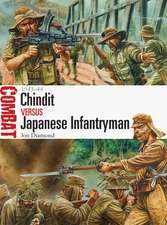Okinawa: The Last Battle (the War in the Pacific)
Autor Roy Edgar Appleman, James M. Burnsen Limba Engleză Paperback – 31 mar 2005
Preț: 270.74 lei
Nou
Puncte Express: 406
Preț estimativ în valută:
51.81€ • 53.89$ • 42.77£
51.81€ • 53.89$ • 42.77£
Carte tipărită la comandă
Livrare economică 14-28 aprilie
Preluare comenzi: 021 569.72.76
Specificații
ISBN-13: 9781410222060
ISBN-10: 1410222063
Pagini: 652
Dimensiuni: 210 x 279 x 35 mm
Greutate: 1.44 kg
Editura: University Press of the Pacific
Locul publicării:United States
ISBN-10: 1410222063
Pagini: 652
Dimensiuni: 210 x 279 x 35 mm
Greutate: 1.44 kg
Editura: University Press of the Pacific
Locul publicării:United States











